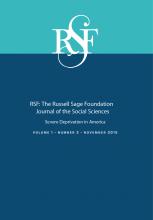Abstract
The United States has experienced dramatic increases in both incarceration rates and the population of insecurely housed or homeless persons since the 1980s. These marginalized populations have strong overlaps, with many people being poor, minority, and from an urban area. That a relationship between homelessness, housing insecurity, and incarceration exists is clear, but the extent and nature of this relationship is not yet adequately understood. We use longitudinal, administrative data on Michigan parolees released in 2003 to examine returning prisoners’ experiences with housing insecurity and homelessness. Our analysis finds relatively low rates of outright homelessness among former prisoners, but very high rates of housing insecurity, much of which is linked to features of community supervision, such as intermediate sanctions, returns to prison, and absconding. We identify risk factors for housing insecurity, including mental illness, substance use, prior incarceration, and homelessness, as well as protective “buffers” against insecurity and homelessness, including earnings and social supports.
- Copyright © 2015 by Russell Sage Foundation. All rights reserved. Printed in the United States of America. No part of this publication may be reproduced, stored in a retrieval system, or transmitted in any form or by any means, electronic, mechanical, photocopying, recording, or otherwise, without the prior written permission of the publisher. Reproduction by the United States Government in whole or in part is permitted for any purpose. This research was funded by the University of Michigan Center for Local, State, and Urban Policy, the National Poverty Center at the University of Michigan, the Russell Sage Foundation, the National Institute of Justice (2008-IJ-CX-0018), the National Science Foundation (SES-1061018, SES-1060708), and the Eunice Kennedy Shriver National Institute of Child Health and Human Development (1R21HD060160 01A1), as well as by a center grant to the Population Studies Center at the University of Michigan from the Eunice Kennedy Shriver National Institute of Child Health and Human Development (R24 HD041028). We thank Paulette Hatchett, our collaborator at the Michigan Department of Corrections, for facilitating access to the data and for advice on the research design; and Steve Heeringa and Zeina Mneimneh, for advice on the sample design. Charley Chilcote, Brenda Hurless, Bianca Espinoza, Andrea Garber, Jessica Wyse, Jonah Siegal, Jay Borchert, Amy Cooter, Jane Rochmes, Jon Tshiamala, Katie Harwood, Elizabeth Sinclair, Carmen Gutierrez, Joanna Wu, Clara Rucker, Michelle Hartzog, Tyrell Connor, Madie Lupei, Elena Kaltsas, Brandon Cory, and Elizabeth Johnston provided excellent research assistance. Direct correspondence to: Claire W. Herbert at clairewh{at}umich.edu, Department of Sociology, University of Michigan, 500 S. State St., Ann Arbor, MI 48109; Jeffrey D. Morenoff at morenoff{at}umich.edu, University of Michigan, 500 S. State St., Ann Arbor, MI 48109; and David J. Harding at dharding{at}berkeley.edu, Department of Sociology, University of California, Berkeley, 462 Barrows Hall, Berkeley, CA 94720.
Open Access Policy: RSF: The Russell Sage Foundation Journal of the Social Sciences is an open access journal. This article is published under a Creative Commons Attribution-NonCommercial-NoDerivs 3.0 Unported License.






